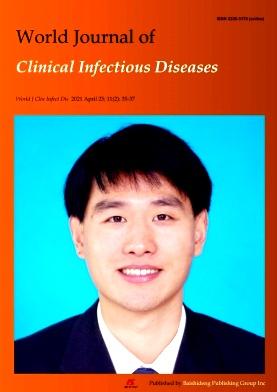Analysis of clinical characteristics and risk factors between elderly patients with severe and nonsevere Omicron variant infection
引用次数: 0
Abstract
BACKGROUND Coronavirus disease 2019 (COVID-19), caused by severe acute respiratory syndrome coronavirus 2 (SARS-CoV-2), has led to millions of confirmed cases and deaths worldwide. Elderly patients are at high risk of developing and dying from COVID-19 due to advanced age, decreased immune function, intense inflammatory response, and comorbidities. Shanghai has experienced a wave of infection with Omicron, a new variant of SARS-CoV-2, since March 2022. There is a pressing need to identify clinical features and risk factors for disease progression among elderly patients with Omicron infection to provide solid evidence for clinical policy-makers, public health officials, researchers, and the general public. AIM To investigate clinical characteristic differences and risk factors between elderly patients with severe and nonsevere Omicron SARS-CoV-2 variant infection. METHODS A total of 328 elderly patients with COVID-19 admitted to the Ninth People’s Hospital Affiliated to Shanghai Jiao Tong University School of Medicine from April 2022 to June 2022 were enrolled and divided into a severe group (82 patients) and a nonsevere group (246 patients) according to the diagnosis and treatment protocol of COVID-19 (version 7). The clinical data and laboratory results of both groups were collected and compared. A chi-square test, t test, Mann-Whitney U test, hierarchical log-rank test, univariate and multivariate logistic regression, and hierarchical analyses were used to determine significant differences. RESULTS The severe group was older (84 vs 74 years, P < 0.001), included more males (57.3% vs 43.9%, P = 0.037), had a lower vaccination rate (P < 0.001), and had a higher proportion of comorbidities, including chronic respiratory disease (P = 0.001), cerebral infarction (P < 0.001), chronic kidney disease (P = 0.002), and neurodegenerative disease (P < 0.001), than the nonsevere group. In addition, severe disease patients had a higher inflammatory index (P < 0.001), greater need for symptomatic treatment (P < 0.001), longer hospital stay (P = 0.011), extended viral shedding time (P = 0.014), and higher mortality than nonsevere disease patients (P < 0.001). No difference was observed in the application of Paxlovid in the severe and nonsevere groups (P = 0.817). Oxygen saturation, cerebral infarction, and D-dimer were predictive factors for developing severe disease in patients with COVID-19, with D-dimer having an excellent role (area under the curve: 90.1%, 95%CI: 86.1-94.0%). In addition, D-dimer was a risk factor for developing severe COVID-19 according to multivariate stratified analysis. CONCLUSION The clinical course of severe COVID-19 is complex, with a higher need for symptomatic treatment. D-dimer is a suitable biomarker for identifying patients at risk for developing severe COVID-19.重度和非重度奥米克龙变异型感染老年患者的临床特征和风险因素分析
背景 由严重急性呼吸系统综合征冠状病毒 2(SARS-CoV-2)引起的冠状病毒病 2019(COVID-19)已在全球导致数百万确诊病例和死亡。由于高龄、免疫功能下降、强烈的炎症反应和合并症,老年患者是 COVID-19 的高危人群。自 2022 年 3 月以来,上海出现了 SARS-CoV-2 的新变种 Omicron 感染潮。目前迫切需要确定老年 Omicron 感染者的临床特征和疾病进展的风险因素,为临床决策者、公共卫生官员、研究人员和公众提供可靠的证据。 目的 研究重度和非重度 SARS-CoV-2 变异型感染老年患者的临床特征差异和风险因素。 方法 选取 2022 年 4 月至 2022 年 6 月期间上海交通大学医学院附属第九人民医院收治的 COVID-19 老年患者 328 例,根据 COVID-19 诊断和治疗方案(第 7 版)分为重症组(82 例)和非重症组(246 例)。收集并比较两组患者的临床数据和实验室结果。采用卡方检验、t 检验、曼-惠特尼 U 检验、层次对数秩检验、单变量和多变量逻辑回归以及层次分析法确定显著差异。 结果 与非重症组相比,重症组年龄更大(84 岁对 74 岁,P < 0.001),男性更多(57.3% 对 43.9%,P = 0.037),疫苗接种率更低(P < 0.001),合并症比例更高,包括慢性呼吸系统疾病(P = 0.001)、脑梗塞(P < 0.001)、慢性肾脏疾病(P = 0.002)和神经退行性疾病(P < 0.001)。此外,与非重症患者相比,重症患者的炎症指数更高(P < 0.001),更需要对症治疗(P < 0.001),住院时间更长(P = 0.011),病毒脱落时间更长(P = 0.014),死亡率更高(P < 0.001)。重症组和非重症组在使用 Paxlovid 方面未发现差异(P = 0.817)。血氧饱和度、脑梗塞和 D-二聚体是 COVID-19 患者发展为重症的预测因素,其中 D-二聚体具有极佳的作用(曲线下面积:90.1%,95%CI:86.1-94.0%)。此外,根据多变量分层分析,D-二聚体也是导致重症 COVID-19 的一个风险因素。 结论 重度 COVID-19 的临床病程复杂,更需要对症治疗。D-二聚体是一种合适的生物标记物,可用于识别有患重症COVID-19风险的患者。
本文章由计算机程序翻译,如有差异,请以英文原文为准。
求助全文
约1分钟内获得全文
求助全文

 求助内容:
求助内容: 应助结果提醒方式:
应助结果提醒方式:


